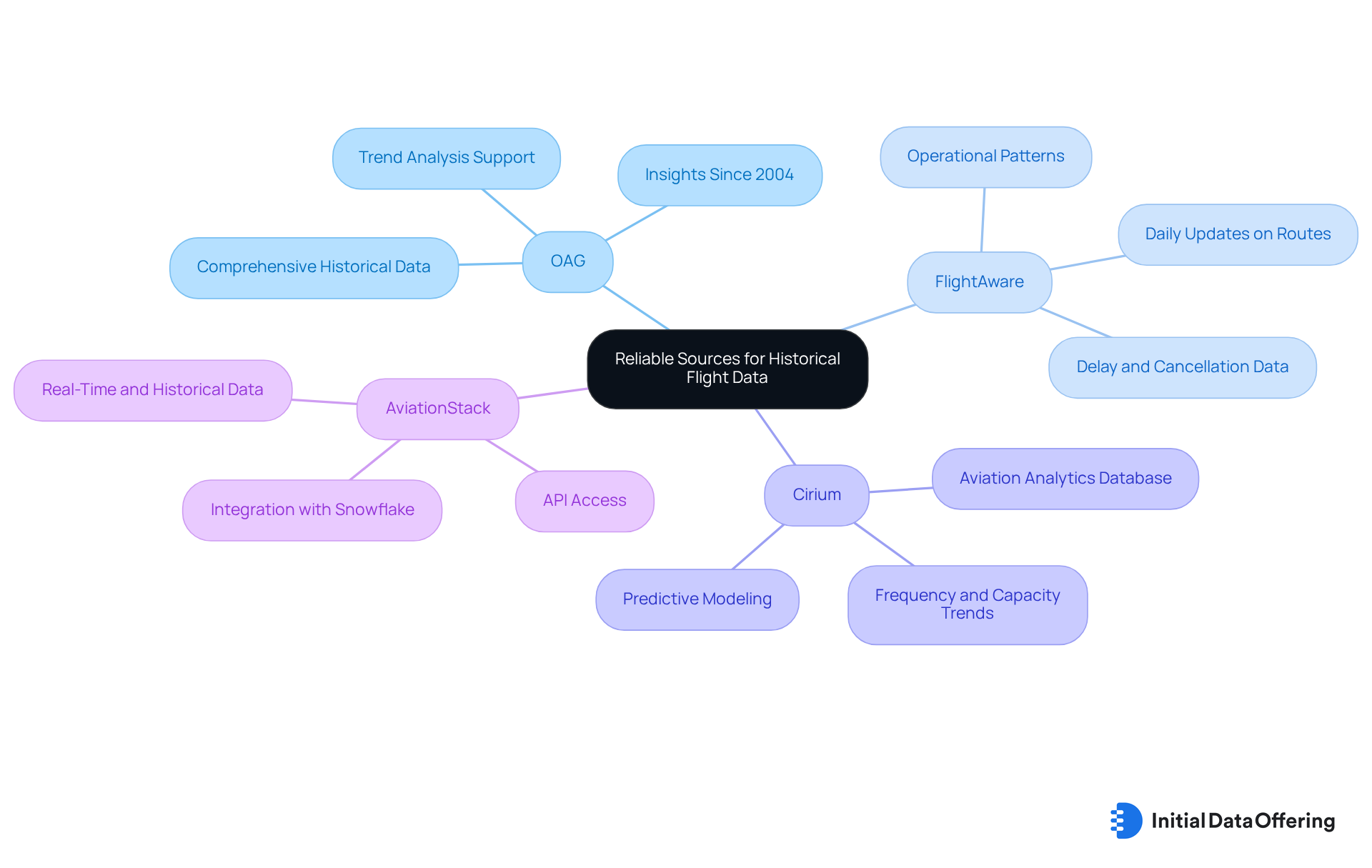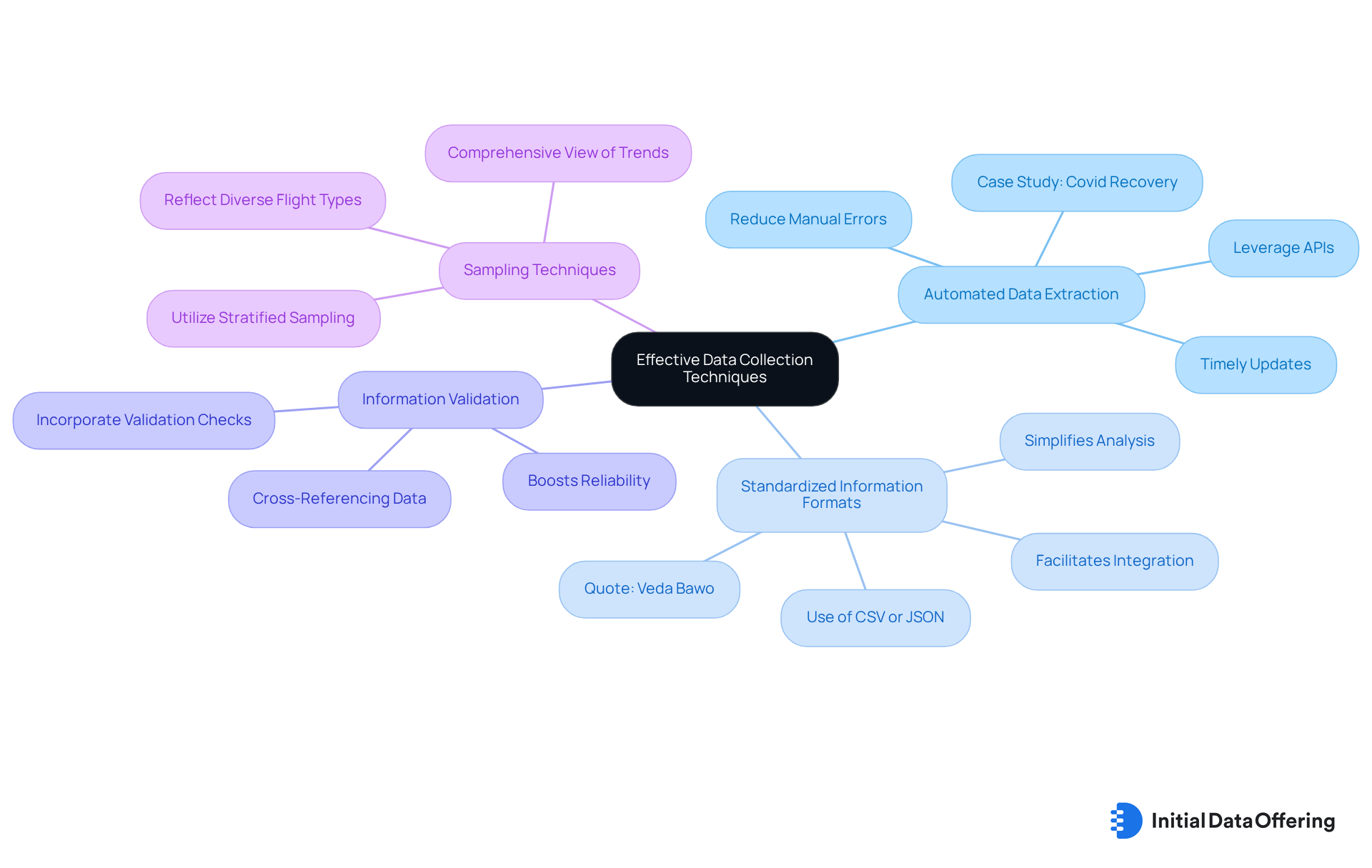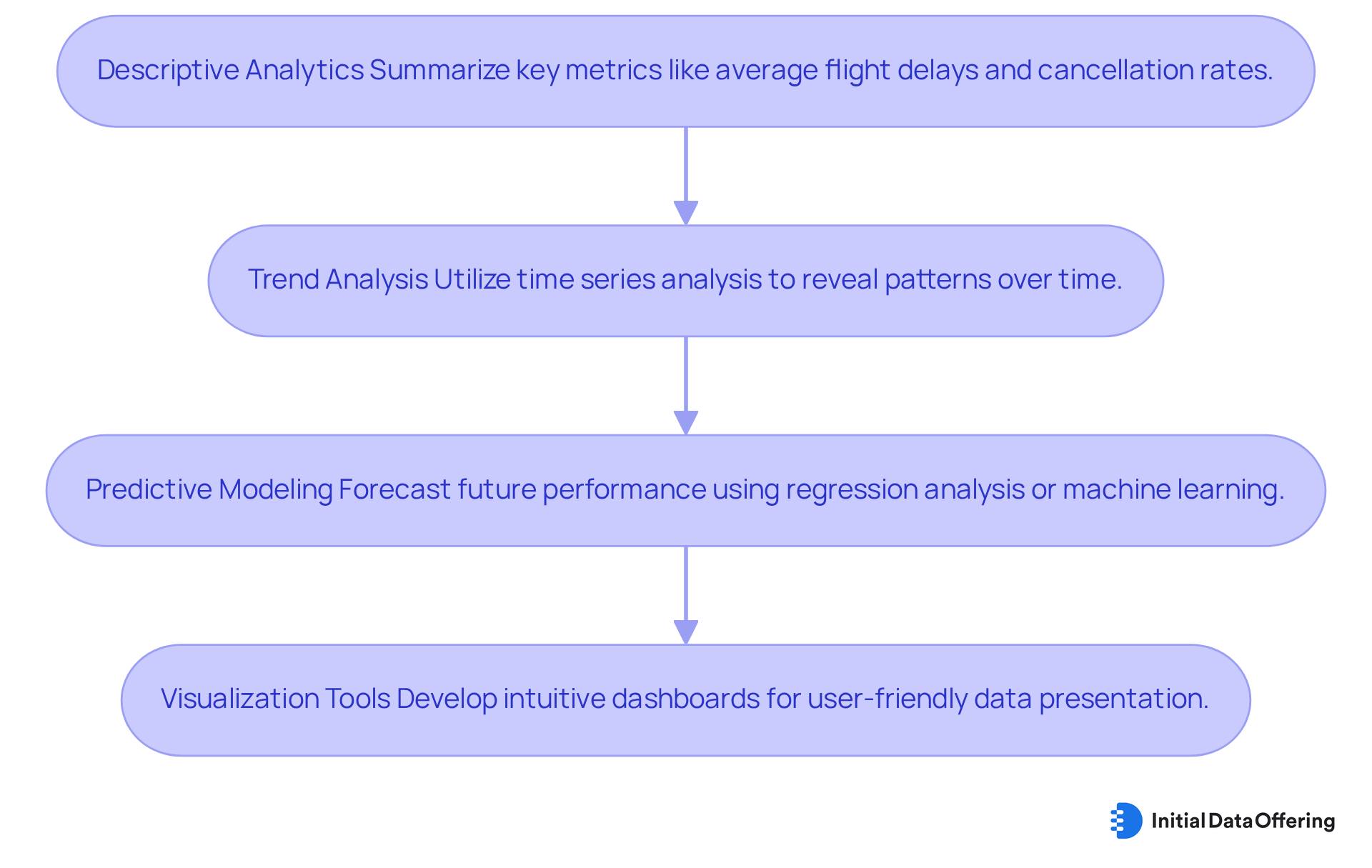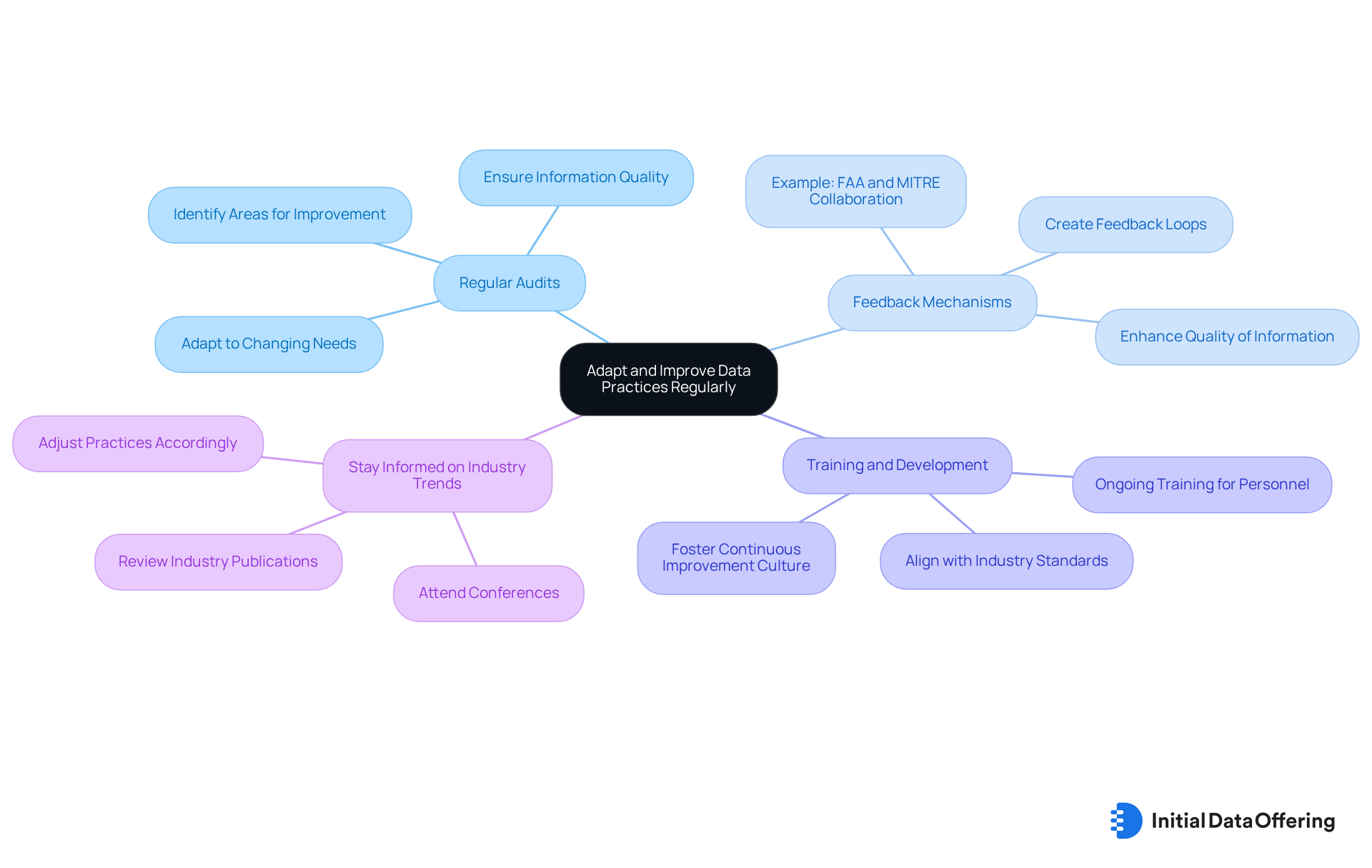4 Best Practices for Analyzing Historical Flight Data

4 Best Practices for Analyzing Historical Flight Data
Overview
This article presents four best practices for analyzing historical flight data, highlighting the significance of:
- Reliable sources
- Effective data collection techniques
- Structured analytical approaches
- Continuous improvements in data practices
By utilizing trustworthy data providers, organizations can ensure the integrity of their analyses. Implementing strategies such as automated data extraction and predictive modeling not only enhances the accuracy of the data but also increases its relevance. Ultimately, these practices lead to informed decision-making in the aviation industry, empowering organizations to navigate complexities with confidence.
How can these strategies be integrated into your current data practices to foster better outcomes?
Introduction
Analyzing historical flight data is essential for understanding trends and making informed decisions within the aviation industry. By utilizing reliable sources and effective data collection techniques, analysts can uncover valuable insights that facilitate operational improvements. However, navigating the complexities of data quality presents a significant challenge, necessitating that the methodologies employed remain both current and effective.
How can organizations refine their practices to enhance data accuracy and adapt to the ever-evolving landscape of aviation analytics?
Identify Reliable Sources for Historical Flight Data
To examine past aviation records efficiently, obtaining information from trustworthy sources is crucial. Some of the most reliable sources include:
- OAG
- FlightAware
- Cirium
- AviationStack
Each offering unique features that enhance data analysis.
OAG provides comprehensive historical flight data, including flight schedules and status information, with insights dating back to 2004. This longevity makes it a valuable resource for trend analysis, ensuring that analysts have access to dependable records. By utilizing OAG, analysts can uncover significant patterns that inform operational decisions.
FlightAware provides extensive historical flight data, which includes information on routes, delays, and cancellations. Such data is essential for grasping operational patterns. Additionally, FlightAware provides daily updates on minimum connection times for travelers and baggage, which enhances operational awareness and improves efficiency in planning.
Cirium boasts a comprehensive database of aviation analytics, featuring historical flight data that is instrumental for predictive modeling and operational enhancements. The Analyser tool from Cirium allows analysts to explore frequency and capacity trends, offering deeper insights into operational activities that can drive strategic improvements.
AviationStack serves as an API that provides access to real-time and historical flight data. This ensures that users can integrate precise details into their applications seamlessly. The partnership with Snowflake further enhances accessibility and integration, simplifying the utilization of these resources for analysts.
By leveraging these trusted providers, analysts can ensure they are working with high-quality information that enhances the reliability of their findings. This ultimately leads to more informed decision-making in the aviation industry, as utilizing these sources empowers professionals to make .

Implement Effective Data Collection Techniques
Analysts should consider several best practices to enhance the quality and reliability of their findings when collecting historical flight data.
- Automated Data Extraction: By leveraging APIs from reputable sources like OAG and FlightAware, analysts can streamline the data collection process. Automation not only reduces manual errors but also ensures timely updates, thereby improving the accuracy of the information. As highlighted in the case study 'Covid Recovery and Future Bookings Visibility,' precise information gathering is crucial during recovery stages, especially when global airline capacity was projected to be around 50% of pre-pandemic levels by the end of 2020.
- Standardized Information Formats: Collecting data in standardized formats such as CSV or JSON simplifies analysis and facilitates seamless integration with various analytical tools. This practice enhances overall efficiency. Veda Bawo aptly states, "You can have all of the fancy tools, but if the quality of your information is not good, you're nowhere," underscoring the importance of quality information formats.
- Information Validation: Incorporating validation checks throughout the data collection process helps identify and rectify discrepancies early on. Cross-referencing data from multiple sources significantly boosts reliability, which is particularly essential in a fragmented information marketplace where data integrity is vital for accurate analysis.
- Sampling Techniques: Utilizing stratified sampling methods ensures that the collected data accurately reflects diverse flight types, routes, and time periods. This approach offers a comprehensive view of historical flight data trends, enriching the analysis. Research on airline capacity and booking ratios illustrates how effective sampling can enhance understanding of .
By implementing these strategies, analysts can substantially improve the quality and trustworthiness of the information collected, leading to more thorough examinations.

Analyze Data for Actionable Insights
Organizations should adopt a structured analytical approach that includes several key steps to extract actionable insights from historical flight data.
- Descriptive Analytics: Organizations should begin with descriptive statistics to summarize key metrics, including average flight delays, cancellation rates, and on-time performance. For instance, in June 2025, the average on-time performance for arrivals across participating airlines was 79.0%, with a cancellation rate of 2.4%. Furthermore, the average delay time for journeys in 2023 was 71.4 minutes, underscoring the significance of understanding operational efficiency. This foundational analysis of provides a clear picture of current performance and highlights areas for improvement.
- Trend Analysis: Next, organizations can utilize time series analysis to reveal patterns over time, including seasonal variations in delays and cancellations. For example, a 32% increase in delays across major U.S. airlines was reported in Q1 2025, emphasizing the need for proactive resource planning and performance forecasting. How can airlines adapt their strategies in response to such trends? This analysis not only identifies challenges but also informs strategic adjustments.
- Predictive Modeling: Employing predictive analytics techniques, such as regression analysis or machine learning algorithms, enables organizations to forecast future performance of journeys based on historical flight data. Dr. Marcus Green notes that the biggest root cause of delayed flights is often issues within the airline's operations. This understanding can significantly enhance proactive decision-making, allowing airlines to foresee and mitigate operational challenges effectively.
- Visualization Tools: Lastly, organizations should utilize visualization platforms such as Tableau or Power BI to develop intuitive dashboards that present information in a user-friendly manner. Effective visualizations can help stakeholders quickly comprehend intricate information patterns, facilitating informed discussions and strategic planning. How can these visual tools enhance stakeholder engagement and decision-making?
By implementing these analytical techniques, organizations can derive valuable insights that drive strategic decisions and improve overall operational performance in the aviation industry.

Adapt and Improve Data Practices Regularly
To maintain effective and relevant data practices, organizations should implement the following strategies:
- Regular Audits: Conducting periodic audits of data collection and analysis processes is essential for identifying areas needing improvement. This practice not only aids in preserving information quality but also guarantees that the information stays pertinent to current operational requirements. Regular audits ensure that organizations can adapt to changing needs and enhance their data-driven decision-making processes.
- Feedback Mechanisms: Creating feedback loops with stakeholders is essential for collecting information on the effectiveness of practices. These mechanisms enable informed modifications and improvements, ultimately resulting in enhanced quality of information. For instance, the FAA's collaboration with MITRE Corp. in the Aviation Safety Information Analysis and Sharing program exemplifies how shared insights can enhance overall aviation safety by identifying widespread issues from isolated incidents. Furthermore, as mentioned, information quality problems are often keenly experienced by analysts and scientists, highlighting the necessity for strong feedback systems that can address these challenges effectively.
- Training and Development: Investing in ongoing training for personnel engaged in information management and analysis is essential. Keeping the team informed about the latest tools and methodologies enhances overall performance and ensures that practices are aligned with industry standards. This commitment to professional development not only boosts individual capabilities but also fosters a culture of continuous improvement within the organization.
- Stay Informed on Industry Trends: Regularly reviewing industry publications and attending conferences helps organizations remain updated on emerging trends and technologies in analytics. This knowledge is essential for adjusting information practices to address changing challenges and opportunities. By staying informed, organizations can proactively adapt their strategies and maintain a competitive edge.
By committing to these continuous improvement strategies, organizations can ensure their information practices evolve alongside industry changes, maximizing the value derived from historical flight data. The tragic loss of 67 lives in the 1994 American Eagle Flight 4184 crash underscores the critical importance of data quality in enhancing safety outcomes. How can your organization implement these strategies to improve its data practices and ultimately enhance safety and efficiency?

Conclusion
Focusing on best practices for analyzing historical flight data allows organizations to significantly enhance their decision-making processes and operational efficiency. Reliable sources such as OAG, FlightAware, Cirium, and AviationStack provide essential data that forms the backbone of effective analysis. By implementing structured data collection techniques—such as automated extraction and standardized formats—organizations can ensure that the information gathered is both accurate and actionable.
This article highlights critical strategies for extracting meaningful insights from historical flight data. These strategies include:
- Descriptive analytics
- Trend analysis
- Predictive modeling
- The use of visualization tools
Each step plays a vital role in transforming raw data into valuable intelligence that informs strategic planning and operational improvements. Furthermore, the importance of regular audits, feedback mechanisms, ongoing training, and staying informed on industry trends cannot be overstated. These practices foster a culture of continuous improvement and adaptability.
In conclusion, the aviation industry stands to benefit immensely from a commitment to high-quality data practices and insightful analysis. By adopting these best practices, organizations can enhance their operational performance and contribute to safer, more efficient air travel. Embracing these strategies is not merely a recommendation; it is a necessity for any aviation entity aiming to thrive in a data-driven landscape.
Frequently Asked Questions
Why is it important to identify reliable sources for historical flight data?
Identifying reliable sources for historical flight data is crucial for efficiently examining past aviation records and ensuring access to dependable information that enhances data analysis and informs operational decisions.
What are some of the most reliable sources for historical flight data?
Some of the most reliable sources include OAG, FlightAware, Cirium, and AviationStack, each offering unique features that enhance data analysis.
What does OAG provide in terms of historical flight data?
OAG provides comprehensive historical flight data, including flight schedules and status information, with insights dating back to 2004, making it valuable for trend analysis and operational decision-making.
What kind of data does FlightAware offer?
FlightAware offers extensive historical flight data that includes information on routes, delays, and cancellations, which is essential for understanding operational patterns. It also provides daily updates on minimum connection times for travelers and baggage.
How does Cirium contribute to historical flight data analysis?
Cirium boasts a comprehensive database of aviation analytics, featuring historical flight data that is instrumental for predictive modeling and operational enhancements. Its Analyser tool allows analysts to explore frequency and capacity trends.
What is AviationStack and how does it function?
AviationStack is an API that provides access to real-time and historical flight data, allowing users to integrate precise details into their applications seamlessly. Its partnership with Snowflake enhances accessibility and integration for analysts.
How do these reliable sources improve decision-making in the aviation industry?
By leveraging trusted providers like OAG, FlightAware, Cirium, and AviationStack, analysts can work with high-quality information that enhances the reliability of their findings, ultimately leading to more informed, data-driven decisions in the aviation industry.